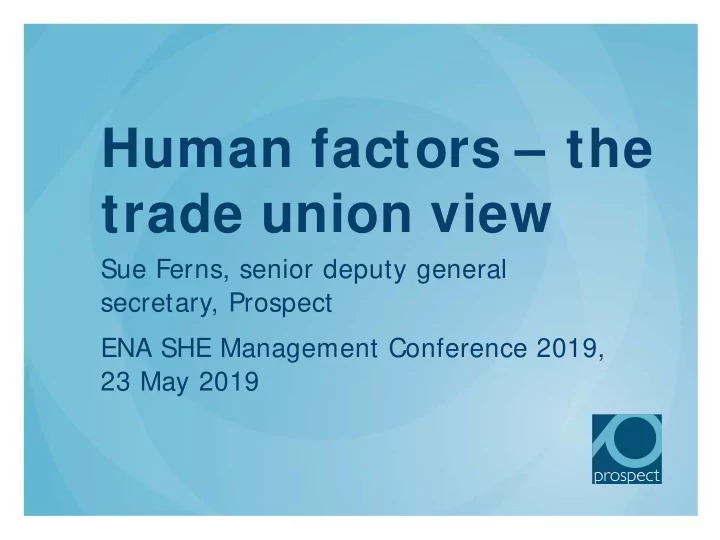

Human factors – the trade union view Sue Ferns, senior deputy general secretary, Prospect ENA SHE Management Conference 2019, 23 May 2019
How often do you feel overwhelmed or highly stressed at work? Every day, 9% Never, 4% Very Most of the Some of the occasionally, time, 24% time, 42% 20% 0% 10% 20% 30% 40% 50% 60% 70% 80% 90% 100% How would you describe morale at your workplace compared to last year? Better, 5% Same, 26% Worse, 67% 0% 10% 20% 30% 40% 50% 60% 70% 80% 90% 100%
Typical daily workload Very light, 1% Extremely About right, Heavy, 47% heavy, 27% 24% Light, 1% 0% 10% 20% 30% 40% 50% 60% 70% 80% 90% 100% How often do you work more than your contracted hours? Rarely, 10% Occasionally, Very often, 31% Often, 28% 27% Never 4% 0% 10% 20% 30% 40% 50% 60% 70% 80% 90% 100%
Have you ever felt too fatigued to perform your job safely? DK, 7% Yes, 31% No, 62% 0% 10% 20% 30% 40% 50% 60% 70% 80% 90% 100% I f yes, did you feel comfortable telling your employer? DK, 2% Yes, 32% No, 66% 0% 10% 20% 30% 40% 50% 60% 70% 80% 90% 100%
Prospect’s expectations We expect employers to: carry out a “suitable and sufficient” stress risk assessment remove or minimise organisational sources of stress work with H&S reps to tackle stress Our activity: Training all new reps in stress risk assessment Provide reps with updates on new stress research New members’ guide on stress prevention and toolkit for evaluating stress risk assessments
The Management Standards • Demands – workload, work patterns, work environment • Control – how much say a person has in the way they do their work • Support – encouragement, sponsorship and resources provided by employer, line manager and colleagues • Relationships – avoiding conflict and dealing with unacceptable behaviour • Role – whether people understand their role and do not have conflicting roles • Change – how organisational change is managed and communicated • Justice? • Equality, diversity and inclusion?
HSE expectations “We want to see: “a significant increase in the number of employers taking a proactive (rather than reactive) stance to managing work related stress through the Management Standards approach or other suitable risk assessment methodology; “more HR and health and safety professionals trained and competent to implement Management Standards approaches within their organisations”
Do we need to reframe the discussion around stress? A physical injury is damage or harm to the body caused by external force Stress can therefore be thought of as “ mental injury” – damage or harm caused by an external force Focus should be on what has happened to employees, not what is wrong with them Removes any notion of individual susceptibility, which has no basis in research
Powering I mprovement 2020-2025 How do we sustain improvements made in past years? How do we improve the links between Powering Improvement, the national HESAC and company HESACs? How do we make Powering Improvement relevant to the challenges the industry will face in the coming years? How do jointly implement the findings of the HSL research report?
Recommend
More recommend